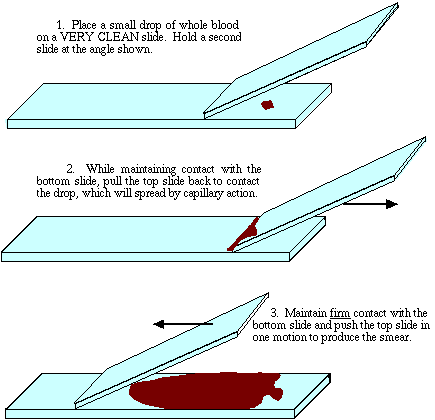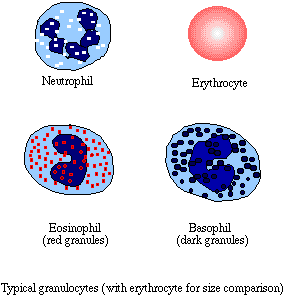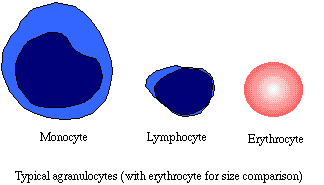
Home
Studies
& Data Analysis
Methods
Microscope studies
Flagella experiment
Laboratory math
Blood fractionation
Gel electrophoresis
Protein gel analysis
Mitochondria
Concepts/ theory
Keeping a lab notebook
Writing research papers
Dimensions & units
Using figures (graphs)
Examples of graphs
Experimental error
Representing error
Applying statistics
Principles of microscopy
Solutions & dilutions
Protein assays
Spectrophotometry
Fractionation & centrifugation
Radioisotopes and detection
Guide to the study
Lab part 1
Lab part 2
Lab part 3
Selected methods
Examining a Mammalian Blood Smear
The distribution and appearance of the formed elements of blood can tell a great deal about the condition of the donor. Disproportionate numbers of white cells (leukocytes) and/or the presence of immature leukocytes are indications of a serious disease, as are high or low platelet counts or misshapen red blood cells. The presence of a high proportion of eosinophils (see figure below) suggests a parasitic infection. Actual parasites can be detected in blood, such as the Plasmodium species known to cause malaria. In fact, we have observed heartworm microfilariae (larvae) in blood samples from pound animals.Obviously we must use extreme caution when handling human blood or blood products because of the risk of transmission of the human immunodeficiency virus (HIV). Unfortunately, the use of human blood in teaching labs is no longer practical, although the concerns are more about liability and insurance rather than actual risk (love those lawyers!). As far as we know, animal blood poses no risk from HIV, and very few blood diseases are transmissible from animals to humans. Laboratory bred animals in particular pose essentially no risk at all.
Examinations should be made of freshly collected blood samples. Whole human or animal blood that has been treated with an anticoagulant can be maintained under refrigeration for an extended period of time and remain of use for research or for clinical applications. However, after a few hours, the white blood cells begin to clump and to deteriorate. Some information can be obtained after a day or two, but such smears are usually disappointing compared to those of fresh blood.
Microscopic examination of whole blood begins with the preparation of a smear. A small drop of blood is placed at one end of a very clean glass slide, and the edge of a second slide is drawn across the drop at an angle so that capillary action spreads the drop along the edge. The second slide is then pushed in one smooth motion to the opposite end of the first slide, spreading the drop across the slide to make the smear.

After the smear has dried it can be stained by applying a liberal amount of Wright's stain with a pasteur pipet. Wright's stain contains red and blue dyes that are acidophilic ('acid-loving') and basophilic ('alkaline-loving'), respectively. Avoid skin contact, since most stains are toxic. The stain is allowed to remain on the slide for about 2 minutes, and more is added if it begins to dry up. After a short dip in buffer and/or a rinse in deionized water, the smear is gently blotted dry with bibulous (absorbant) paper. Incidentally, many students have a problem with common sense - my apologies if this insults your intelligence, but DO remove the sheet of bibulous paper from the book before using it for blotting. Don't simply blot the slide onto the entire book.
Microscopic examination of formed elements
Because mammalian red blood cells are biconcave they will not appear as uniform disks in the microscope field. Examination at 400x reveals them to be thin in the center. All of the formed elements should be examined at 1000x using the oil immersion technique in order to make positive identifications and to see the fine detail. The drop of oil should be placed directly on the smear.
Most leukocytes (white blood cells) are larger than the erythrocytes, and unless the donor had a nasty blood disease, they will be much more scarce. The two major categories of leukocytes are the granulocytes and the agranulocytes, based on the presence of visible cytoplasmic granules in one type and the absence of visible granules in the other. Each major type is further composed of recognizable sub-types based on staining properties of the granules, size of cell, and proportion of nuclear to cytoplasmic material.
Granulocytes
Granulocytes are also known as polymorphonuclear leukocytes, or "polys" for short. Most have irregular, lobed nuclei. The cytoplasmic granules contain enzymes involved in detoxification of foreign substances, blood clotting, and various immune responses. The neutrophil, the most common granulocyte in humans, is so named because the cytoplasmic granules remain unstained by acidic or basic dyes. Mature neutrophils have a large nucleus with several lobes, although there may be species differences. Neutrophils with one or two lobes are immature or abnormal. The presence of immature leukocytes can indicate a major infection, blood parasites, or a disease such as leukemia. Neutrophils are capable of ameboid motion under some conditions, and as with some other leukocyte types they can accomplish diapedesis, which is the ability to squeeze through the pores of blood vessels to reach a chemotactic source.

The sex of a blood donor can be determined by examining the neutrophils. Human males have only one copy of the X-chromosome, the genes of which are expressed. In human females, only one X-chromosome in each cell is expressed, while the second is condensed, making the alleles it carries inaccessible. The condensed X-chromosome may jut out as a very small but obvious 'lobe' of the nucleus of the neutrophils, called a Barr body.
Basophils and eosinophils are granulocytes with cytoplasmic granules that stain with basophilic (blue) and acidophilic (red) dyes respectively. Wright-stained basophils are spectacular in appearance, and are usually the rarest of leukocytes. Their granules appear quite large and they stain nearly black, often obscuring the nucleus. The eosinophils, which are often present in large numbers in the presence of a parasitic infection, have numerous red-staining granules.
Agranulocytes
Lymphocytes are smaller than granulocytes, are nearly all nucleus, and typically are nearly as common as neutrophils. The cytoplasm can be seen as a thin area of lighter blue between the nucleus and the cell membrane. Lymphocytes are responsible for the initiation of the immune response and for the acquisition of immunity. Monocytes, the other type of agranulocyte, are much larger than lymphocytes, with a greater ratio of cytoplasm to nucleus. Like neutrophils, monocytes are capable of diapedesis and can respond to chemotactic factors by undergoing hypertrophy (excessive growth) that converts them into macrophages. Macrophages consume foreign substances, such as bacteria, by phagocytosis.

Platelets
The stem cells from which red cells and leukocytes are developed are found in the bone marrow. Also in the bone marrow are giant cells called megakaryocytes. Megakaryocytes disintegrate before enter the bloodstream, so that only the fragments, called platelets, remain. When platelets encounter a damaged surface they swell and stick to the surface and each other to form a plug. The plug seals blood vessels, allowing time for the slower clotting process to take place and form a tight seal. Platelets have no pigmentation, and only lightly stain with Wright's stain, so you may need phase contrast to see them.
Visitors: to ensure that your message is not mistaken for SPAM, please include the acronym "Bios211" in the subject line of e-mail communications
Created by David R. Caprette (caprette@rice.edu), Rice University 15 Aug 96
Updated 30 Jul 12
